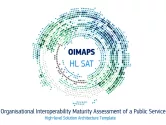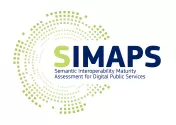Please note that these versions are deprecated and not linked to the latest SIMAPS release.
SIMAPS High-level Solution Architecture Template (HL SAT)
A Solution Architecture Template (SAT) is a specification extending the EIRA providing support to solution architects in a specific solution domain. A SAT contains a motivation (principles, requirements), a goal and a description of the supported functionalities, a sub-set of the EIRA core Architecture Building Blocks (ABBs) covering the four views, a set of specific ABBs extending EIRA's views enabling specific functionalities to be provided by implementations derived from the SAT and the interoperability specifications of selected ABBs and a narrative for each EIRA view.
In EIRA, a High-level (HL) requirement is a statement of a need that must be realized by a solution. This statement is a description of a to-be implemented functional aspect. They do not include any reference to technology specifics like standards. An interoperability requirement is defined as a statement of an interoperable need that must be realized by a system. In EIRA, this statement is a High-level description of a to-be implemented interoperability aspect. An interoperability requirement adds granularity to an interoperability aspect.
SIMAPS v1.0.0 HL SAT models the EIRA semantic view and in particular, the most salient behavioral ABBs that should be considered in order to support the semantic behavioral interoperability of information exchanges between administrations, businesses and citizens. The EIRA semantic behavioral ABBs are source for the identification and documentation of the semantic behavioral interoperability requirements for SIMAPS (Semantic Interoperability Maturity Assessment of a Public Service).
The purpose of this HL SAT is to provide guidance by defining a minimal semantic interoperability architecture to implement the semantic viewpoint of IMAPS (Interoperability Maturity Assessment of a public Service), thus SIMAPS. The SIMAPS HL SAT should allow businesses and public administrations to have a common understanding of the most salient building blocks from the perspective of semantic behavioral interoperability.
The benefits of this HL SAT are the following:
- Serves as a means to perform quality assurance in the design of a digital public service, given a specific use case.
- Provides architects with a common approach to cope with a specific interoperability challenge. It also places the focus on the key-points you need to consider.
- An architect can create a solution architecture by mapping existing Solution Building Blocks (SBBs) to an SAT, based on the interoperability specifications that are provided. This is done by providing SBBs for the ABBs identified in the SAT.
- When an architect creates a SAT, he/she can define the interoperability specifications for the SAT’s ABBs and moreover recommend specific SBBs which produces faster and more interoperable results.
- A SAT can be created within and across the different views of the EIRA. A SAT can then support architects specialised in different interoperability levels.






